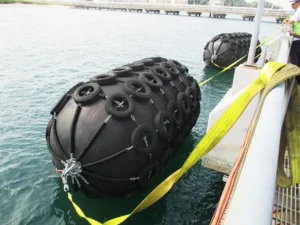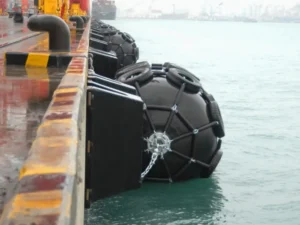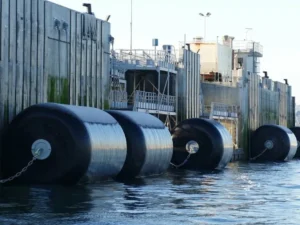Introduction
Have you ever wondered about the ship docking or collisions? How do the ships cope in such a situation and remain safe? If yes, then say welcome to the Fenders — the revolutionary tools for the safety of your vessels and ships. It all started in the 1980s with the first hydro-pneumatic fender. Now, we have various types of fenders. Based on the nature of the protection and conditions, you prefer them. But today, we’ll talk about: pneumatic vs foam-filled fenders. We will shower light on what they are, their advantages, and their differences.
Pneumatic Fenders

Pneumatic fenders are marine bumpers used for ships in the event of collisions. They are air-filled in the core layer of rubber with an outer supportive layer of cord.
High-pressure air in the pneumatic fenders is the game-changer. It absorbs the impact energy while keeping the vessels safe when docking.
Sometimes, we call a Yokohama Fender because of its origin in Yokohama, Japan!
Advantages of Pneumatic Fenders
Pneumatic fenders are the trump card when it comes to ship docking, inclined compression, and transport.
Key benefits include:
-
Highly Adaptable
No matter what ship size you have, pneumatic fenders are the liquids. They adapt the shape of the ships, change their sizes, and help provide extra protection.
Whenever you are docking the ship at an inclined angle, they quickly adjust the protection mechanisms and help in better safety.
Since they have airbags, you can increase or decrease their sizes based on your ship’s weight, size, and the distance you want to keep from other ships.
It will optimize the protection during the collision and help minimize the damage risks to the boats.
-
Easy Transportation
A Yokohama fender guarantees easy transportation. Maybe you are wondering how it is even possible.
Simple. You can deflate them with the valves attached to the fenders. Decrease their size. And take them to distant locations.
On the given location, you can inflate them again. You get reduced headaches for storage and transportation.
-
Quick Installation
The installation process is a piece of cake. No need to enter complexity. In emergency cases, you can install them quickly and bring them into use. Inflation and deflation is not a very hectic process.
Moreover, dismantling is straightforward. Quick and super-fast installation keeps you at ease whenever using them.
-
Low Cost
One of the most enormous benefits of pneumatic fenders is their low costs. You don’t have to invest a fortune in buying them. They are 3X less priced than the foam-filled fenders. Offer a decent lifespan. And save maintenance costs as well.
For airbag filling, high-pressure air is not very expensive. So, you get a dramatic reduction in the overall price of the Yokohama pneumatic fenders.
-
Less Maintenance
You don’t have to go the extra mile for the maintenance. It requires less maintenance. Just keep a weather eye on the airbags and high-pressure air. Check the performance over the period.
No need for regular replacements as well. In some cases, airbags might need replacement after two years. It even reduces the costs of maintenance as well.

Foam Filled Fenders
Foam-filled fenders have the same goal of collision energy absorptions, but the construction is different. They have four layers:
- Inner Steel Core Layer
- Closed Cell Foam Layer. It often has the materials such as EVA (Ethylene Vinyl Acetate) or PE (Polyethylene).
- Reinforced cord layer
- Outermost elastomeric skin
Foam-filled fenders have water resistance. It makes them safe when used for marine purposes. Plus, they offer excellent support for ship docking purposes.
Benefits of Foam Filled Fenders
Foam-filled fenders are the kingmakers of the fenders industry. They have a quite high efficiency and long life. Take a look at the key features of foam-filled fenders.
-
Highly efficient
The sole purpose of foam-filled fenders is to offer extreme protection levels to ships and vessels. They have a high-density construction material, leading to high energy absorption.
Your boats will be safer even during severe collisions, all credit to the high-density energy absorption material in the foam-filled fenders.
Furthermore, they have 40% more efficiency compared to Yokohama Fenders. Such high reliability makes it extremely popular in marine applications.
-
Long Life
Forget the replacement until it is 10+ years old. And that is necessary only if it gets deformed over time and loses its efficiency. Foam-filled fenders have quite a long life owing to their foam constructions that do not have risks of puncture, unlike pneumatic fenders.
Moreover, they are resistant to deformation and offer extended protection to your boats during docking and collision. One more treat for you is the corrosion resistance. It prevents quick deterioration and decreasing performance.
-
Less Maintenance
You don’t have to go for 12 months of airbag checkups as you do in the pneumatic fenders. It also eliminates the air pressure check-up as well.
So, when do you need the maintenance?
Usually, regular inspection is enough for its performance. Make sure there is no deformation of the foam materials. And you get the optimal protection. In case of any red flag, such as deformation or loss of expected efficiency needs, you ought to have a proper inspection and maintenance.
Due to less maintenance, you save hassles and costs on maintenance.
-
Work under harsh weather conditions
Marine conditions have to encounter winds, rains, and heavy storms sometimes. The robust build of foam-filled fenders ensures sustainability even during the wind. High-density material absorbs most of the wind pressure. And corrosion resistance keeps it alive in the rainy season.
There are no more worries about the fluctuations in the weather conditions. You just get the optimal performance in every situation.

The differences: Pneumatic VS Foam-Filled Fenders
Pneumatic fenders and foam-filled fenders have a lot of differences in the working mechanism, but one thing is common — protect the ships during collision!
Have a quick overview of the differences in both ship fenders.
-
Durability
How do you define durability? Longer life?
Usually, it is an uphill battle to determine which ship fenders are the finest. But one thing’s for sure— foam-filled fenders don’t deflate. That means proper maintenance can help you work with them for extended periods.
On the other hand, a Yokohama Pneumatic Fender is prone to puncture. A single puncture and your whole dreams of working with it for years blow out of the water.
However, a Yokohama Pneumatic Fender works for 8-10 years. In contrast, foam fenders have an average lifespan of 10-25 years.
-
Performance
We can’t declare pneumatic or foam fenders the beast of performance. It all depends on the quality of manufacturing, components, and manufacturers.
From a technical point of view, what is better in performance?
Foam-filled fenders have 40% more efficiency in giving protection. Plus, they have no disadvantages due to punctures. So, you can expect better performance. Still, there is one dry spell — the deformation. If they get deformed, forget the expected performance because they are no longer leading lights for the protection work.
Pneumatic fenders, on the other hand, have a high pressure. They do not provide very much cushion but still have good protection. Keep them away from punctures if you want to get the expected performance.
-
Maintenance
If you are concerned about the maintenance, leave it on the bay. No need for extra tension about maintenance.
For pneumatic fenders, you have got heaven on the earth. You can deflate them. Transport them. And use them with proper installation anywhere and everywhere. But there is one maintenance case here as well.
Every 12 months, you need to check the air in the pneumatic fenders and get them filled.
In the case of foam-filled fenders, there is little maintenance, all thanks to the foam filled in them. A regular inspection would be better at this point.
-
Price
This is where Pneumatic fenders have a clear-cut edge. Do you know why? Because the main component of the pneumatic fenders is air. And it is 100% free. However, you need to create a high pressure that may have some costs, but it is not as high as the foam-filled fenders.
Foam fenders have a foam layer that must absorb all the collision energy. Therefore, the amount of the material is relatively high because of collision energy absorption.
It has led to 3X more costs for the foam vendors than the pneumatic fenders.
Conclusion
Everyone longs for durable and highly efficient fenders. That is a turning point where people make mistakes. They work with dodgy marine rubber fenders manufacturers.
Is that the case with you? Then, no worries, we have the best rubber fender supplier — JerryBorg Marine .
We have years of experience under our belt and focus on manufacturing premium quality ISO-verified fenders. Say goodbye to low-quality deals. Grab Affordable and Qualitative Marine Fenders, Airbags, and Machinery! Visit our quality foam-filled and pneumatic fenders.
